
Pairing Yucca
7 inspirational ideas
Contents
Here’s a plant that certainly has its share of spines! From the gigantic Yucca elephantipes standing 6m tall, to the small Yucca recurvifolia at 60 cm, Yuccas can fit into any garden. Despite their exotic appearance, some can withstand temperatures as low as -15°C, and their graphic, spiky look allows for the creation of stunning landscape scenes. So if you’re wondering how to incorporate Yucca outdoors and which plants to pair it with, discover our 7 pairing ideas, ranging from a soft perennial bed to terraced gardens, including rockeries or even in the planters of an urban garden. You’re sure to find a style that suits you with Yucca: it can even find its place by the water!
Is Yucca suitable for your garden? Find out easily in just a few clicks with our web application Plantfit
→ And to become an expert on Yucca cultivation, check out our guide: Outdoor Yucca: choice, planting, maintenance in pot or in garden
In a terraced garden
When there are steep slopes, the garden benefits from being arranged in terraces, which are flat, successive levels held back by stone walls. The plants grown in these conditions must be able to thrive in a relatively small volume of soil, often limited in width and with well-draining soil. In these terraces, Yucca aloifolia or Aloe-leafed Yucca can be very well combined with agaves to form the medium plant structure of the terraces. The upper stratum, at the back, can consist of olive trees with a controlled silhouette and spread through annual Chamaerops humilis, hardy palms down to -12°C.
At the foot of the masses of creeping rosemary, Rosmarinus officinalis ‘Prostratus’, Silver Mound Artemisia schmidtiana ‘Nana’, a perennial groundcover with silver foliage, and Sedum takesimense ‘Atlantis’, remarkably variegated and bright. These outstanding groundcovers will save you from tedious weeding chores.

Rosmarinus officinalis ‘Prostratus’, terraced garden atmosphere with Yuccas, Sedum takesimense ‘Atlantis’, and Artemisia schmidtiana ‘Nana’
Read also
Choosing a yuccaTo structure a lush perennial border
By their graphic nature, Yuccas bring structure to borders and balance the movements against sometimes rather unruly perennials. Pair Yucca rostrata with the stunning Verbena bonariensis for a successful combination of grey foliage and mauve-violet. This Yucca forms a thick, upright trunk topped with a bristly ball of numerous narrow leaves. It can reach 4 m in height at maturity and grows quite slowly. The Gaura lindheimeri in white and the Salvia farinacea will complete the colour palette and ensure uninterrupted flowering throughout the summer.
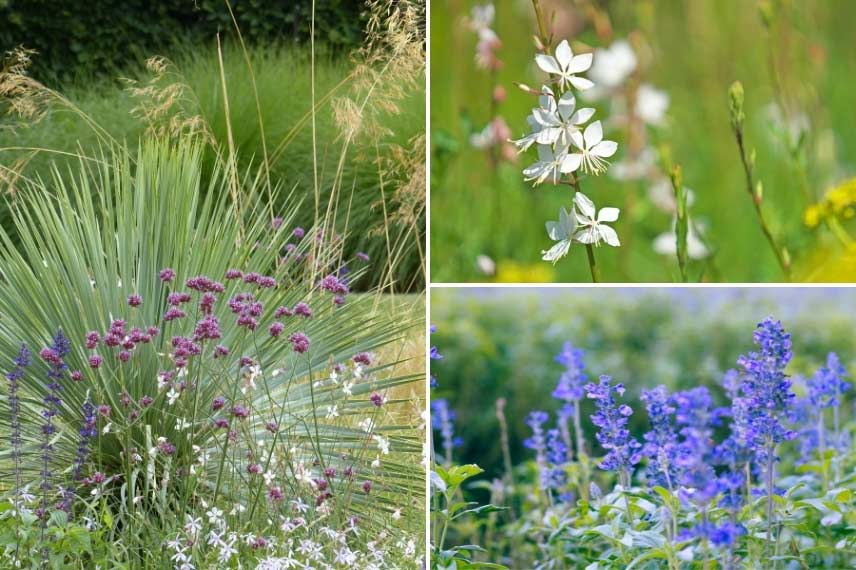
On the left: Yucca rostrata and Verbena bonariensis, On the right: Gaura lindheimeri and Salvia farinacea
Discover other Yucca
View all →Available in 1 sizes
Available in 3 sizes
Available in 1 sizes
Available in 2 sizes
Available in 2 sizes
Available in 1 sizes
Available in 1 sizes
Available in 1 sizes
Available in 1 sizes
Available in 1 sizes
In a dry garden
Originating from the arid regions of North America, Yuccas thrive in dry gardens, whether desert-like or Mediterranean. Their natural companions are Agaves, and Opuntias or Prickly Pears, which also thrive in poor, well-draining, stony soils. The magnificent Yucca gloriosa ‘Variegata‘, also known as Spanish Dagger, features rosettes of tough, rigid blue-green leaves marginate with yellow. Their tips are sharp and spiky, so be cautious about placing them at the back or at height to prevent accidents, especially with children. The summer flowering of this Yucca is stunning: it produces a tall spike adorned with numerous white bells, delightfully fragrant.
To complement the blooms, plant a Aloe arborescens and a Beschorneria or Mexican Lily. A bit tender (hardy down to -8/-10°C) but very drought-resistant, it has the advantage of having beautiful non-spiky greyish leaves.
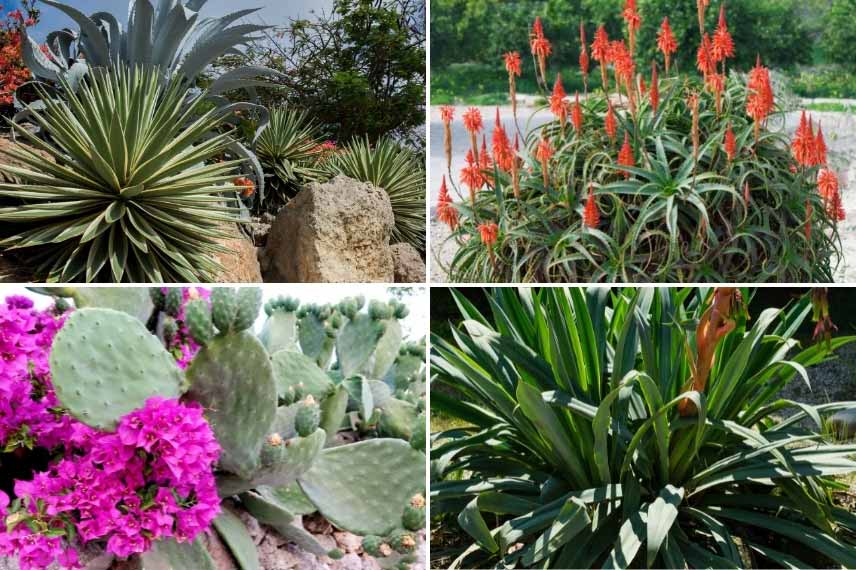
From left to right and top to bottom: Yucca gloriosa ‘Variegata’ and Agave americana, Aloe arborescens, Opuntia and Beschorneria yuccoides
→ Discover Gwenaëlle’s tips: Designing a dry exotic garden – Our tips for creating a dry exotic garden
By a pond
One does not spontaneously think of installing Yucca in a humid and shaded environment, but it can indeed be placed a little back from the immediate edges of a small pond or at the edge of a waterproof basin, where its roots are not at risk of suffering from excess moisture. On the banks of this basin and among stones arranged as naturally as possible, for example, plant Yucca gloriosa with bluish-green leaves and beautiful white summer flowering, or the Yucca filamentosa ‘Colour Guard’, variegated green and yellow.
The Lobelia speciosa ‘Tania’ and Astilbe arendsii ‘Anita Pfeiffer’ with its bright pink plume flowers, will take their place in cool soil to bring colour and softness to these banks, while the Thalia dealbata, also known as White Thalia or Water Canna, an aquatic perennial, will plunge its roots into the water to green the pond.

Yucca gloriosa, Lobelia speciosa ‘Tania’ and Astilbe arendsii ‘Anita Pfeiffer’, Thalia dealbata and Yucca filamentosa
In a rockery
Like the dry garden, the rockery naturally welcomes the Yucca, a plant that is always beautiful and requires no maintenance. Install between lovely natural stones the Yucca rostrata, the Yucca flaccida ‘Golden Sword’ which is very bright and colourful with its vivid yellow leaves margined with green, or perhaps the blue Yucca rigida if you have the space and wish to add height to the arrangement. It can indeed grow up to 3m tall.
Accompanied by autumn Stonecrops Sedum ‘Sunkissed’, which are very easy and accommodating, carpet the base of the yuccas with Sedum spurium ‘Album Superbum’ that will weave between the stones and Phlox subulata. This very floriferous groundcover with evergreen foliage will brighten everything up with its charming pink flowers.
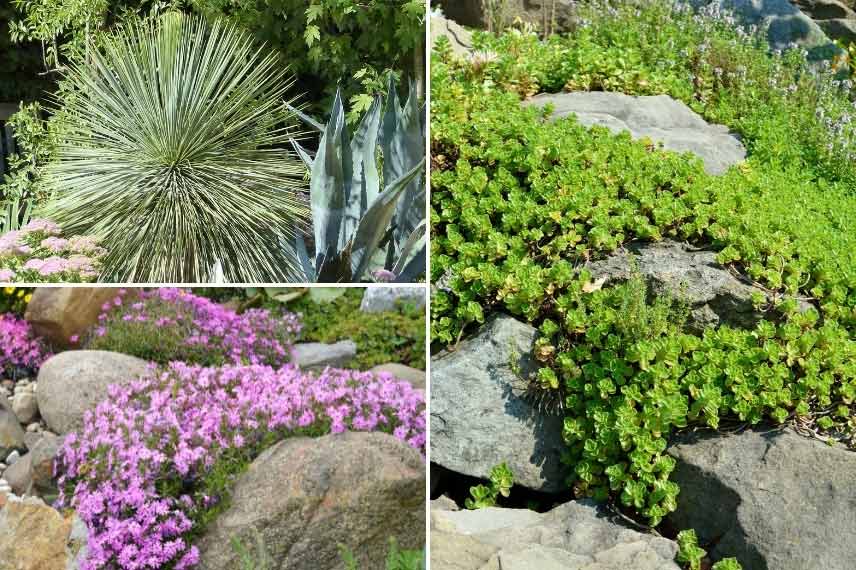
Yucca rostrata and Agave americana, Phlox subulata and Sedum spurium ‘Album Superbum’
By the edge of a natural pool
Natural or ecological pools have the advantage of filtering water through the action of plants rather than chemicals. Their surroundings are generally landscaped to give them the appearance of a wild pond. Yuccas can be great allies for landscaping around a pool as they require almost no maintenance and do not litter their surroundings. Plant the Yucca filamentosa ‘Colour Guard’, variegated, and the Yucca filamentosa ‘Ivory Tower’, blue-green marginate with cream white to protect bathers from their spines, although these varieties are less spiky than others. Their spectacular summer flowering, in the form of large spikes of big cream white bells, is very ornamental.
To accompany them in this range of non-littering and easy-to-cultivate plants, plant masses of Bulbine frutescens and Bulbine frutescens ‘Hallmarck’. Their long, slender succulent leaves form dense, evergreen clumps, bearing numerous fine floral stems with pretty star-shaped yellow flowers for the first and orange for the second. At the edge, the Carex oshimensis ‘Evergold’, an evergreen groundcover grass, will form elegant dense clumps of trailing yellow leaves edged with green.
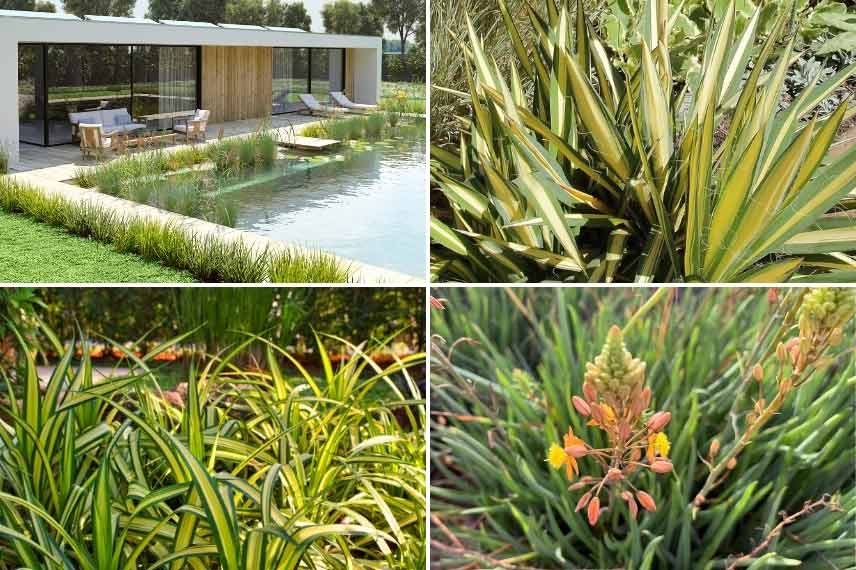
Natural atmosphere around a biological pool, Yucca filamentosa ‘Colour Guard’, Carex oshimensis ‘Evergold’ and Bulbine frutescens ‘Hallmarck’
→ Discover Virginie’s tips: Landscaping around a pool in 5 styles – Suitable plants and tips
In a planter on an urban patio
The Yucca fits admirably into urban displays with a graphic and contemporary look. In a patio or a small city garden, especially if you have little time to devote to gardening (or simply lack the desire), it will provide a green and elegant presence all year round. Plant moderate-growing Yuccas, such as Yucca Filamentosa with green leaves or ‘Bright Edge’ with green leaves marginate in yellow and edged with white filaments. If space is really tight, opt for the compact Yucca recurvifolia ‘Bright Star’, which is also variegated and will not exceed 60 cm in height and width. It can be planted in the ground or in large containers.
The Winter Horsetail Equisetum hyemale will accompany the Yucca beautifully with its equally graphic appearance of long, erect cylindrical stems. For an easy and long-lasting touch of colour, plant the bush sage Salvia ‘Papajan’, which flowers from June to July and continues into the heart of winter.
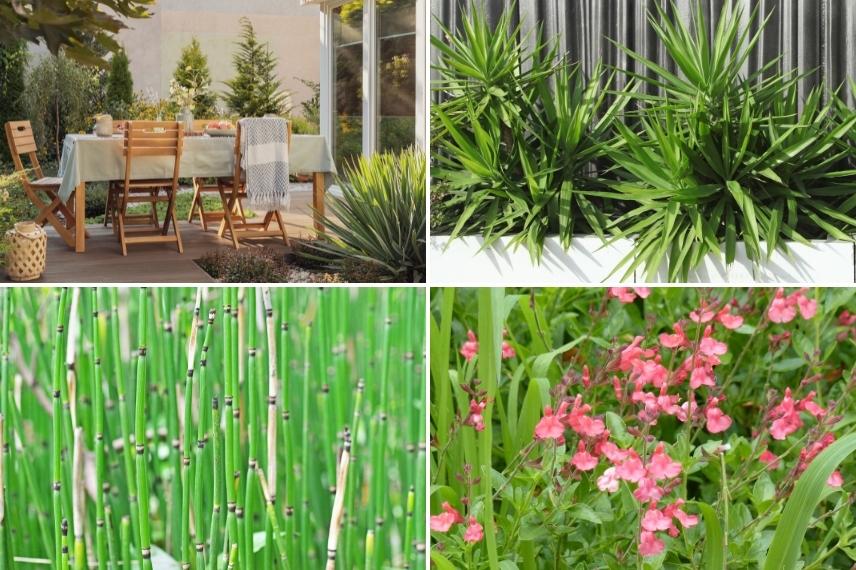
Urban patio atmosphere, Yuccas in containers, Equisetum hyemale and Salvia ‘Papajan’
- Subscribe!
- Contents

































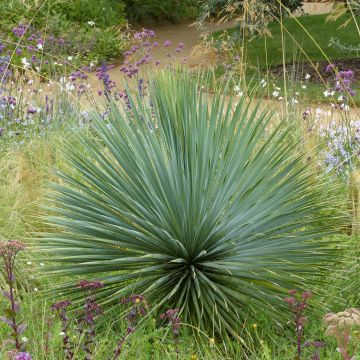
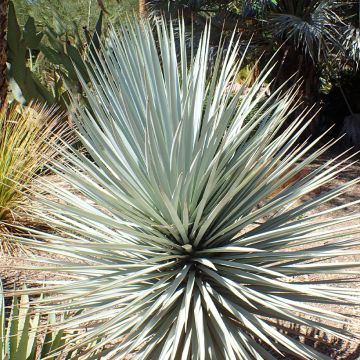
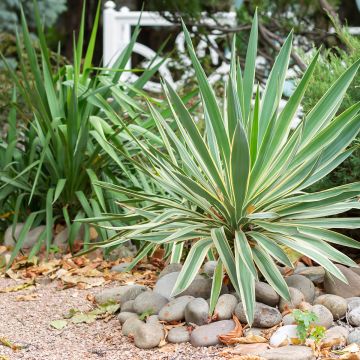
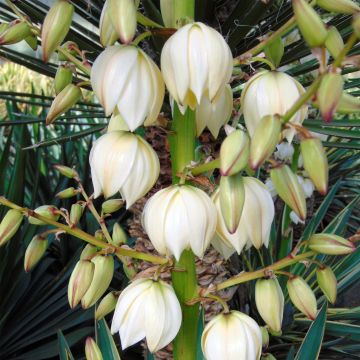
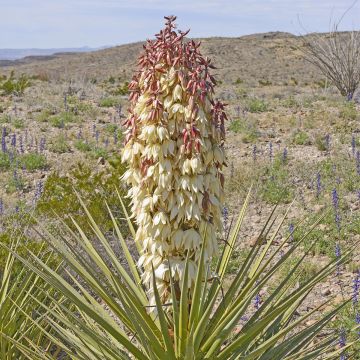
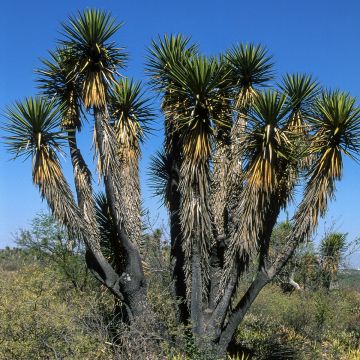
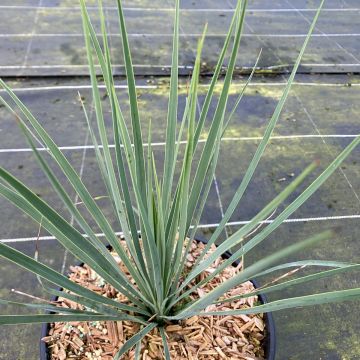

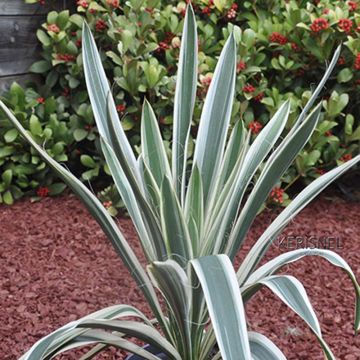
Comments